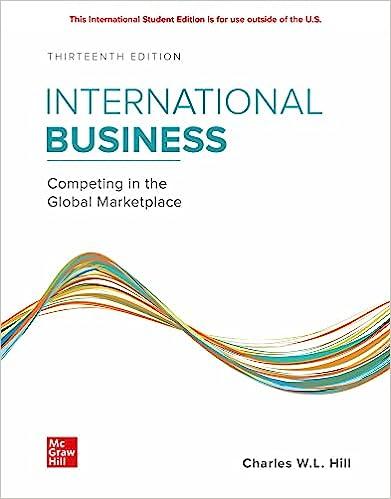In 2015, the government of Saudi Arabia announced an ambitious plan, known as Vision 2030, to diversify
Question:
In 2015, the government of Saudi Arabia announced an ambitious plan, known as Vision 2030, to diversify the economy beyond oil. Saudi’s plans to modernize its economy will require copious funding, something that will strain the finances of the desert kingdom. The country relies heavily on oil, with 87 percent of the budget, 42 percent of GDP, and 90 percent of export earnings being derived from oil revenues. As a consequence of lower oil prices and higher government outlays, the Saudi government has recently been running large budget deficits. In 2016, the deficit hit $90 billion, or 13 percent of GDP. To raise the funds for Vision 2030, therefore, the government decided to sell off shares in Saudi Aramco, the state-run oil company that has exclusive control over Saudi Arabia’s oil reserves.
Saudi Aramco is one of the largest enterprises on earth. Saudi Arabia possesses about 16 percent of the world’s oil reserves, including some of the lowest-cost reserves on the planet. This gives Saudi Aramco 10 times the reserves of the largest private oil company, ExxonMobil. Saudi government estimates suggest that Saudi Aramco is worth $2 trillion.
Based on this valuation, the government is proposing to sell 5 percent of the shares of Saudi Aramco to private investors, which would raise $100 billion in capital for the government—enough to fund aggressive investments in nonoil ventures to support Vision 2030. If this comes to pass, the initial public offering (IPO) of Saudi Aramco will be the largest in history by a wide margin.
Raising $100 billion in capital has its challenges, not least of which is that the Saudi stock exchange, or Tadawul, is far too small and illiquid to absorb such a massive stock offering. As it stands, the entire Saudi stock market only lists 170 companies and has a total market capitalization of around $350 billion. Offering 5 percent of Saudi Aramco through the Tadawul will not result in a high price for the stock; there is simply not enough local demand to support that. The only way to raise $100 billion is to offer stock of Saudi Aramco for sale not just on the Tadawul, but also on one or more additional large and highly liquid stock markets. The exchanges being considered include New York, London, and Singapore. For example, with a market capitalization of more than $20 trillion, the New York Stock Exchange is far more able to absorb the offering than the Tadawul. Listing on multiple exchanges will make the IPO available to a much wider pool of investors, thus potentially increasing demand and driving up the price, making it more likely that the Saudi government will hit its target of raising $100 billion.
If Saudi Aramco does list on larger exchanges, which seems highly likely, it will have to abide by the strict accounting regulations and reporting requirements of those markets. Regular financial reporting will increase the transparency of Saudi Aramco, which in turn will increase investor confidence in the IPO and thus increase demand and drive up the market price of the stock. Another benefit of listing on multiple exchanges is that it will make it easier for Saudi Aramco to undertake additional stock offerings down the road and to issue debt securities in those markets.
Initially, the IPO was planned for 2018. However, skepticism from potential foreign investors about the official estimates of Saudi Aramco’s oil reserves resulted in the IPO being delayed. To satisfy potential investors, Saudi Arabia commissioned an independent audit from a respected Dallas-based consultancy. The results of this audit, released in early 2019, confirmed that the kingdom controls more than 260 billion barrels in oil reserves.
Other factors have also pushed back the IPO date, including an ongoing dispute over where to list the IPO. Apparently, not all Saudis are happy with the notion of listing the IPO in New York, or any other foreign financial center for that matter. With the date of the IPO still uncertain, Saudi Aramco has decided to issue bonds in the second quarter of 2019. In order to tap into the global debt market, Aramco will release additional financial information, offering a deeper glimpse into a private company whose inner workings are very opaque. As for the IPO, currently it is targeted for 2021.
Questions
1. Why does the government of Saudi Arabia want Saudi Aramco to undertake an IPO? Should the fact that the funds raised will not be used to invest in Saudi Aramco matter to investors?
2. Saudi Aramco is a tightly held state-owned enterprise with a history of secrecy. How might this impact the IPO?
What concerns might potential investors have? How might these concerns impact Saudi Aramco’ s cost of capital? What does Saudi Aramco need to do to reassure investors and deal with these concerns?
3. Could Saudi Aramco raise $100 billion by offering shares for sale on just the local Tadawul stock exchange? Why is it considering other stock exchanges? If it does restrict where it offers shares, what might the potential impact be?
4. If you were advising Saudi Aramco on their IPO strategy, what would your advice be?
Step by Step Answer:

ISE International Business Competing In The Global Marketplace
ISBN: 9781260575866
13th International Edition
Authors: Charles Hill





